Egans testbank Study guides, Class notes & Summaries
Looking for the best study guides, study notes and summaries about Egans testbank? On this page you'll find 33 study documents about Egans testbank.
All 33 results
Sort by
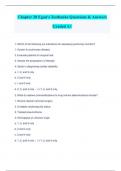
-
Chapter 20 Egan's Testbanks Questions & Answers Graded A+
- Exam (elaborations) • 32 pages • 2023
- Available in package deal
-
- $13.49
- + learn more
1. Which of the following are indications for assessing pulmonary function? 1. Screen for pulmonary disease. 2. Evaluate patients for surgical risk. 3. Assess the progression of disease. 4. Assist in diagnosing cardiac disability. a. 1, 2, and 3 only b. 2 and 4 only c. 1 and 3 only d. 2, 3, and 4 only - 1, 2, and 3 only 2. What do relative contraindications for lung volume determinations include? 1. Recent cataract removal surgery 2. Unstable cardiovascular status 3. Treated pneumoth...
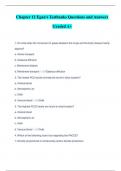
-
Chapter 12 Egan's Testbanks Questions and Answers Graded A+
- Exam (elaborations) • 41 pages • 2023
- Available in package deal
-
- $14.49
- + learn more
1. On what does the movement of gases between the lungs and the body tissues mainly depend? a. Active transport b. Gaseous diffusion c. Membrane dialysis d. Membrane transport - Gaseous diffusion 2. The lowest PO2 would normally be found in what location? a. Arterial blood b. Atmospheric air c. Cells d. Venous blood - Cells 3. The highest PCO2 levels are found in what location? a. Arterial blood b. Atmospheric air c. Cells d. Venous blood - Cells
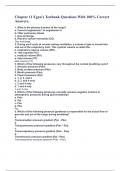
-
Chapter 11 Egan's Testbank Questions With 100% Correct Answers.
- Exam (elaborations) • 18 pages • 2023
-
- $13.39
- + learn more
Chapter 11 Egan's Testbank Questions With 100% Correct Answers. 1. What is the primary function of the lungs? a. Convert angiotensin I to angiotensin II. b. Filter pulmonary blood. c. Gas exchange. d. Remove carbon monoxide (CO). Gas exchange. 2. During each cycle of normal resting ventilation, a volume of gas is moved into and out of the respiratory tract. This cyclical volume is called the: a. inspiratory reserve volume (IRV). b. vital capacity (VC). c. residual volume (RV). d. t...
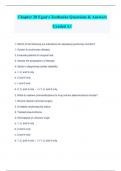
-
Chapter 20 Egan's Testbanks Questions & Answers Graded A+
- Exam (elaborations) • 32 pages • 2023
- Available in package deal
-
- $13.49
- + learn more
Chapter 20 Egan's Testbanks Questions & Answers Graded A+ 1. Which of the following are indications for assessing pulmonary function? 1. Screen for pulmonary disease. 2. Evaluate patients for surgical risk. 3. Assess the progression of disease. 4. Assist in diagnosing cardiac disability. a. 1, 2, and 3 only b. 2 and 4 only c. 1 and 3 only d. 2, 3, and 4 only - 1, 2, and 3 only 2. What do relative contraindications for lung volume determinations include? 1. Recent cataract removal su...
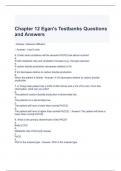
-
Chapter 12 Egan's Testbanks Questions and Answers
- Exam (elaborations) • 22 pages • 2023
- Available in package deal
-
- $12.99
- + learn more
Chapter 12 Egan's Testbanks Questions and Answers
Chapter 11 Egan's Testbank Questions With 100% Correct Answers.
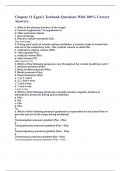
-
Chapter 11 Egan's Testbank Questions With 100% Correct Answers.
- Exam (elaborations) • 18 pages • 2024
-
- $13.89
- + learn more
Chapter 11 Egan's Testbank Questions With 100% Correct Answers. 1. What is the primary function of the lungs? a. Convert angiotensin I to angiotensin II. b. Filter pulmonary blood. c. Gas exchange. d. Remove carbon monoxide (CO). Gas exchange. 2. During each cycle of normal resting ventilation, a volume of gas is moved into and out of the respiratory tract. This cyclical volume is called the: a. inspiratory reserve volume (IRV). b. vital capacity (VC). c. residual volume (RV). d. t...

-
Chapter 20 Egan's Testbanks Questions & Answers Graded A+
- Exam (elaborations) • 32 pages • 2023
-
- $13.39
- + learn more
1. Which of the following are indications for assessing pulmonary function? 1. Screen for pulmonary disease. 2. Evaluate patients for surgical risk. 3. Assess the progression of disease. 4. Assist in diagnosing cardiac disability. a. 1, 2, and 3 only b. 2 and 4 only c. 1 and 3 only d. 2, 3, and 4 only - 1, 2, and 3 only 2. What do relative contraindications for lung volume determinations include? 1. Recent cataract removal surgery 2. Unstable cardiovascular status 3. Treated pneumoth...

-
Chapter 12 Egan's Testbanks Questions and Answers Graded A+
- Exam (elaborations) • 41 pages • 2023
-
- $14.49
- + learn more
1. On what does the movement of gases between the lungs and the body tissues mainly depend? a. Active transport b. Gaseous diffusion c. Membrane dialysis d. Membrane transport - Gaseous diffusion 2. The lowest PO2 would normally be found in what location? a. Arterial blood b. Atmospheric air c. Cells d. Venous blood - Cells 3. The highest PCO2 levels are found in what location? a. Arterial blood b. Atmospheric air c. Cells d. Venous blood - Cells 4. Which of the following is/are ...
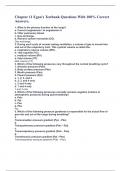
-
Chapter 11 Egan's Testbank Questions With 100% Correct Answers.
- Exam (elaborations) • 18 pages • 2023
-
- $14.49
- + learn more
Chapter 11 Egan's Testbank Questions With 100% Correct Answers. 1. What is the primary function of the lungs? a. Convert angiotensin I to angiotensin II. b. Filter pulmonary blood. c. Gas exchange. d. Remove carbon monoxide (CO). Gas exchange. 2. During each cycle of normal resting ventilation, a volume of gas is moved into and out of the respiratory tract. This cyclical volume is called the: a. inspiratory reserve volume (IRV). b. vital capacity (VC). c. residual volume (RV). d. t...

Did you know that on average a seller on Stuvia earns $82 per month selling study resources? Hmm, hint, hint. Discover all about earning on Stuvia



